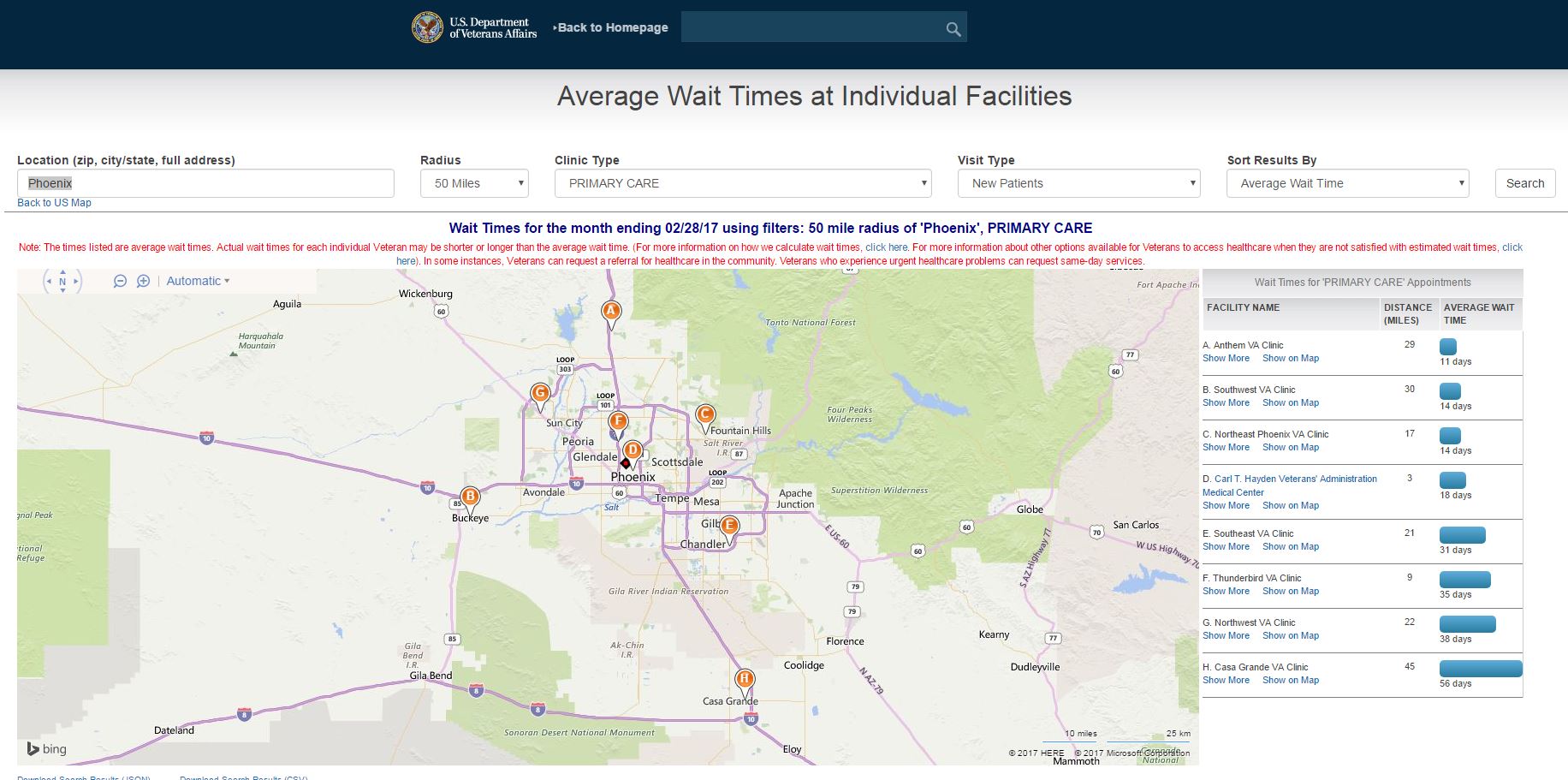
3 years after Phoenix scandal, VA launches new online wait time tool
The Veterans Affairs Department soft-launched a new online tool that lets veterans search for VA medical facilities and their average wait times within a specif...
The Veterans Affairs Department soft-launched a new tool Wednesday that’s designed to help veterans find average wait times and other information on VA medical centers and clinics across the country.
Veterans can now visit AccesstoCare.va.gov to compare the distance, wait times, services, quality and feedback for VA medical facilities within a specific mile radius.
The launch comes nearly three years after reports found veterans waiting weeks and months for appointments at the Phoenix VA Medical Center, prompting a leadership and organizational shakeup across the department. Inspector general investigations found similar problems at other medical centers across the country. Patient schedulers falsified wait times at dozens of medical facilities nationwide, while many faced severe training and staffing shortfalls.
The department called it a major breakthrough on its efforts to improve accountability and transparency.
“This is really giving you everything, in terms of the things that are working, things that are not working and things we have to improve on,” Dr. Poonam Alaigh, acting undersecretary for health, said during an Apr. 12 demo with reporters and veterans service organizations. “This is completely transparent.”
The site is designed to show veterans their options and answer four basic questions:
- How quickly can my VA facility see me?
- How satisfied are veterans with their care in my facility?
- How does care in my VA facility compare to other hospitals in the area?
- How is the VA system doing with access nationally?
Veterans can search for wait times if they’re a new or returning patient, or clarify the search to show results for primary care, mental health, women’s health, cardiology and others.
“I could go to a facility that could see me in two days all the way down to a facility that sees me in seven days,” Alaigh said looking at search results for a return visit in Phoenix, Arizona. “Depending on my priority, depending on my need, I know where I should be going or where I want to go based on how long I can wait.

Veterans can also see what services a medical center offers, such as a walk-in clinic, an emergency room, tele-health or walk-in options for primary and mental health care.
Another option shows veteran’ satisfaction scores for each facility, while a third button on the site compiles Centers for Medicare and Medicaid quality measures for both VA and non-VA hospitals and clinics so veterans can compare.
“They realize that this is what’s needed for them to redesign their internal processes and evolve into a more veterans-centric organization,” Alaigh said of the department’s medical facilities.
The department is tweaking some aspects of the site, with the goal of having the first version live by May 1. The U.S. Digital Service will work with VA on the second version of the site, which the department will connect to Vets.gov. Both USDS and VA have been iteratively working on Vets.gov, the department’s one-stop site that guides veterans through the disability and health care application processes.
VA project mangers brought in a few contractors to help with the first iteration of the access site. The department is also making small changes and new features as veterans give them more feedback.
The department believes having all of this information in one place forces VA medical facilities to improve.
“This will help bring the rigor and the urgency internally to start now becoming competitive, because all this data is transparent, and veterans will vote with their feet,” Alaigh said. “They’re going to go to the place that meets most of their needs.”
For now, VA will update the data every month but said it will eventually add new information in real time. Alaigh said veterans should look to the recent changes the department has made to its scheduling process as a reassurance that the wait times they see on the site are accurate and that VA medical facilities haven’t adopted the same practices that were uncovered in Phoenix.
“We’ve simplified the scheduling system,” she said. “Up until about a month or ago or so, we had at least four or five different ways of scheduling. We had [the] preferred date, desired date, negotiated date, create date, clinically indicated date, I mean there were all kinds of dates that the schedulers would use to schedule an appointment. We’ve retired all those dates. The only date we have now is [the] patient-indicated date — so what is it that the veteran wants and what is it that the veteran and the physician together have decided would be the best time to come back.”
Previous problems in Phoenix and around the country also stemmed from the department’s outdated and complicated scheduling systems.
VA is evaluating a few different, simplified scheduling tools now. One, called the Medical Appointment Scheduling System (MASS), is a commercial solution that’s in pilot-mode now.
The chairman of the House Veterans Affairs Committee, a group that’s often been one of the department’s toughest critics, praised the new tool.
“I thank Secretary Shulkin for making this important data readily available to improve the veteran’s experience at VA and increase accountability at the department,” Rep. Phil Roe (R-Tenn.) said in a statement. “Transparency is a critical component of VA reform, and I’m glad the Trump administration is thinking outside the box. Just this week I visited VA facilities in West Los Angeles and Phoenix, and I’m proud of the work being done around the country to provide veterans with timely access to quality health care. There is still an incredible amount of work that must be done, but I’m optimistic about the direction VA is headed.”
Copyright © 2024 Federal News Network. All rights reserved. This website is not intended for users located within the European Economic Area.
Nicole Ogrysko is a reporter for Federal News Network focusing on the federal workforce and federal pay and benefits.
Follow @nogryskoWFED




